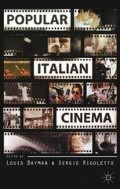Abstract
In early twentieth-century Italy, cinema had already gained a place as a mass phenomenon. Around 1905 a capillary proliferation of movie theatres (Bernardini, 1981: 15–36) began remodelling the urban landscape, transforming the spaces of social life and redefining urban culture. In 1906 the magazine L’Albo d’oro noted that in Rome, after the opening of the Cinema Moderno, ‘movie theatres started springing up like mushrooms, so now […] one can find a movie theatre on every corner’ (‘I cinematografi’, 1906: 36), whilst in Naples novelist Matilde Serao denounced cinema as a new kind of ‘virus’ having a profound impact on contemporary society:
Today cinema is the ultimate expression of Neapolitan epidemics and manias, the dernier cri of success. […] Cinema reigns supreme, ruling and dominating and bossing around and invading everything, society life, charity, the arts, the theatre!
(Gibus [Serao], 1906)2
Access this chapter
Tax calculation will be finalised at checkout
Purchases are for personal use only
Preview
Unable to display preview. Download preview PDF.
Bibliography
Annunziata, L. (2010) ‘On Cinema. The Novelist Matilde Serao and the New Medium’, in S. Bull and A. Söderbergh Widding, (eds) Not so Silent: Women in Cinema before Sound (Stockholm: Acta Universitatis Stockholmiensis), 85–95.
Baldus, R. (1914) ‘I capolavori. Lyda Borelli e La memoria dell’altro’, La Cinematografia Italiana ed Estera, 31 March, 11–18.
Bernardini, A. (1981) Cinema muto italiano. II. Industria e organizzazione dello spettacolo. 1905–1909 (Roma-Bari: Laterza).
Bernardini, A. (1991) ‘Industrializzazione e classi sociali’, in R. Renzi (ed.), Sperduto nel buio. Il cinema muto italiano e il suo tempo (1905–1930) (Bologna: Cappelli editore), 22–33.
Blom, I. (2003) ‘All the Same or Strategies of Difference. Early Italian Comedy in International Perspective’, in A. Antonini (ed.), Il film e i suoi multipli/ Film and its multiples (Udine: Forum), 465–79.
Brunetta, G. P. (1998) ‘Cantami o diva…’, Fotogenia, 4–5, 27–43.
Brunetta, G. P. (2009) The History of Italian Cinema: A Guide to Italian Films from its Origins to the Twenty-First Century, trans. J. Parzen (Princeton, NJ. and Oxford: Princeton University Press).
Buck-Morss, S. (1986) ‘The Flâneur, the Sandwichman, and the Whore: The Politics of Loitering’, New German Critique, 39, 99–140.
Bush, S. (1913) ‘Italy’s Film Center’, The Moving Picture World, 5 July, 25.
Camasio, S. and Oxilia, N. (1982) Addio giovinezza! Commedia in 3 atti (Roma: Il Sigillo).
Casetti, F. (2008) Eye of the Century: Film, Experience, Modernity (New York: Columbia University Press).
Crainquebille [Thovez, E.] (1908) ‘L’arte di celluloide’, La Stampa, 29 July, 3.
Dalle Vacche, A. (2008) Diva: Defiance and Passion in Early Italian Cinema (Austin, TX: University of Texas Press).
Fasolo, O. (1907) ‘Il cinema… svelato’, Natura e Arte, 1 February, 331.
Ferri, G. (1906) ‘Tra le quinte del cinematografo’, La Lettura, 9 September, 794–800.
Friedberg, A. (1993) Window Shopping: Cinema and the Postmodern (Berkeley, CA, and Los Angeles: University of California Press).
Gambacorti, I. (2003) Storie di cinema e letteratura. Verga, Gozzano, D’Annunzio (Firenze: Società Editrice Fiorentina).
Ginex, G. (ed.) (2004) Divine. Emilio Sommariva fotografo. Opere scelte 1910–1930 (Busto Arsizio, Varese: Nomos).
Guccini, G. (1994) ‘Tecnicismi borelliani’, Cinegrafie, IV:7, May, 118–26.
‘I cinematografi’ (1906) L’Albo d’oro, June, 36.
‘Il pubblico del cinematografo’ (1908) La Rivista Fono-Cinematografica, February, 19–20.
Jandelli, C. (2006) Le dive italiane del cinema muto (Palermo: L’Epos).
Mosconi, E. (2006) L’impressione del film. Contributi per una storia culturale del cinema italiano: 1895–1945 (Milano: Vita e Pensiero).
Mosconi, E. (2010) ‘Lyda Borelli as a Liberty Icon’, in S. Bull and A. Söderbergh Widding (eds), Not so Silent: Women in Cinema before Sound (Stockholm: Acta Universitatis Stockholmiensis), 137–48.
Nunes Vais, M. (1974) Mario Nunes Vais fotografo, exhibition catalogue, May–June, Firenze, Palazzo Vecchio, Sala d’Armi.
Gaio [Orvieto, G.] (1907) ‘Il cinematografo’, Corriere della sera, 21 August, 3.
Oxilia, N. (1973) Poesie, ed. R. Tessari (Napoli: Guida).
Palazzeschi, A. (1913) L’incendiario 1905–09 (Milano: Edizioni Futuriste di Poesia).
Papini, G. (1907) ‘La filosofia del cinematografo’, La Stampa, 18–19 May, 1–2.
Pestelli, G. (1914) ‘Filmopoli’, Il Secolo XX, February, 177.
Rabinovitz, L. (1998) For the Love of Pleasure. Women, Movies, and Culture in Turn-of-the-Century Chicago (New Brunswick: Rutgers University Press).
Renzi, L. (1994) ‘Donne angeliche e demoniache tra cultura europea e cinema muto italiano’, Cinegrafie, IV:7, May, 103–17.
Rondolino, G. (1993) I giorni di Cabiria (Torino: Lindau).
Rondolino, G. (1998) ‘Affatica meno e rende di più. Il cinema muto a Torino’, in P. Bertetto and G. Rondolino (eds), Cabiria e il suo tempo (Milano: Il Castoro), 19–30.
Gibus [Serao, M.] (1906) ‘Cinematografeide!’, Il giorno, 30 March.
Tallone, G. (2005) Cesare Tallone (Milano: Electa).
Vanzi, P. (1918) ‘Lungo metraggio’, La Vita Cinematografica, December, 152–6.
Welle, J. (2004) ‘Early cinema, Dante’s Inferno of 1911, and the origins of Italian film culture’, in A. Iannucci (ed.), Dante, Cinema, and Television (Toronto: University of Toronto Press), 21–50.
Editor information
Editors and Affiliations
Copyright information
© 2013 Irene Lottini
About this chapter
Cite this chapter
Lottini, I. (2013). ‘Il delirio del lungo metraggio’: Cinema as Mass Phenomenon in Early Twentieth-Century Italian Culture. In: Bayman, L., Rigoletto, S. (eds) Popular Italian Cinema. Palgrave Macmillan, London. https://doi.org/10.1057/9781137305657_9
Download citation
DOI: https://doi.org/10.1057/9781137305657_9
Publisher Name: Palgrave Macmillan, London
Print ISBN: 978-1-349-33586-2
Online ISBN: 978-1-137-30565-7
eBook Packages: Palgrave Media & Culture CollectionLiterature, Cultural and Media Studies (R0)

